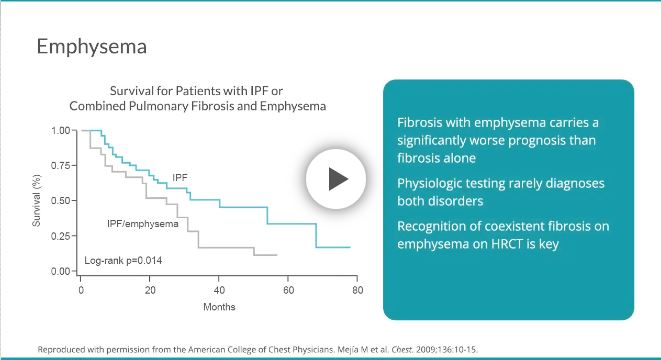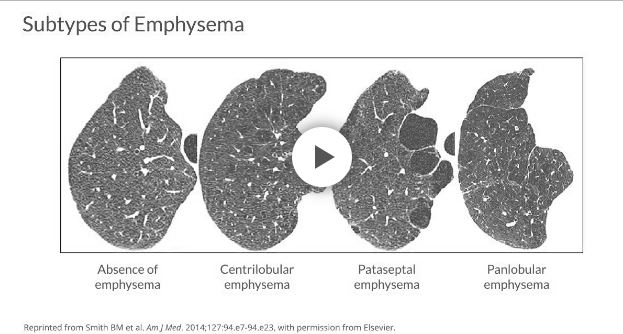
Patients with IPF are at high risk for having emphysema,11 which carries a significantly poorer outcome than IPF alone.5 Emphysema and pulmonary fibrosis have opposing physiologic effects, often leading to apparent conserved lung function during pulmonary function tests.12 Therefore, recognition of coexistent fibrosis and emphysema on HRCT is of utmost importance as physiologic testing rarely diagnoses both disorders.12
Emphysema is characterized by permanently enlarged airspaces with destruction of alveolar walls.7 On HRCT, emphysema appears as focal areas of low attenuation, often without visible walls.7 Centrilobular emphysema has a nonuniform, centrilobular distribution predominantly localized to the upper lung.7 Paraseptal emphysema is subpleural and peribronchovascular, interspersed with areas of intact interlobular septa.7 Bullae may also be present on HRCT scans of patients with paraseptal emphysema.7 In patients with emphysema and fibrosis, fibrotic changes are often lower-lung predominant, while emphysema is often upper-lung predominant, spatially distinguishing the features.

Patients with IPF are at high risk for having emphysema,11 which carries a significantly poorer outcome than IPF alone.5 Emphysema and pulmonary fibrosis have opposing physiologic effects, often leading to apparent conserved lung function during pulmonary function tests.12 Therefore, recognition of coexistent fibrosis and emphysema on HRCT is of utmost importance as physiologic testing rarely diagnoses both disorders.12
Emphysema is characterized by permanently enlarged airspaces with destruction of alveolar walls.7 On HRCT, emphysema appears as focal areas of low attenuation, often without visible walls.7 Centrilobular emphysema has a nonuniform, centrilobular distribution predominantly localized to the upper lung.7 Paraseptal emphysema is subpleural and peribronchovascular, interspersed with areas of intact interlobular septa.7 Bullae may also be present on HRCT scans of patients with paraseptal emphysema.7 In patients with emphysema and fibrosis, fibrotic changes are often lower-lung predominant, while emphysema is often upper-lung predominant, spatially distinguishing the features.
